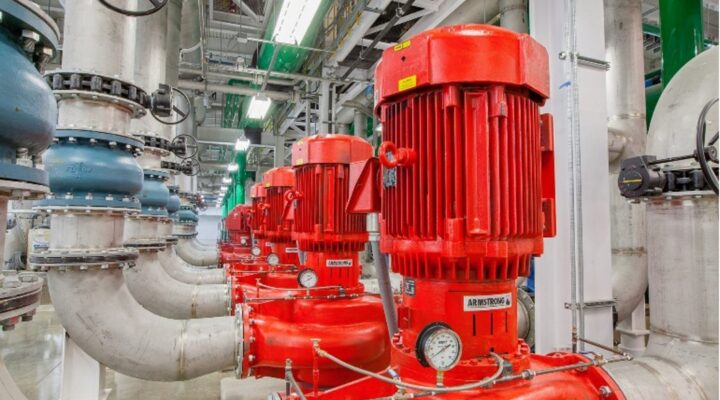When you look at a commercial building you notice the same thing everyone else does: its façade. But what lies beneath that brick, concrete, and glass is an intricate network of technology that works together to keep a building operating at all times. We talk about the big things, such as HVAC and lighting, but we rarely discuss the technology behind how water in buildings is used and how it gets to its final destination. So let’s talk about pumps.
Pumps are at the heart of many buildings. Traditional constantload pumps are common in older systems and use valves to control the flow of water. These pump motors work around the clock at one speed, on or off—regardless of water needs in the building. With this type of system, water is ready to be delivered at any time, but you don’t always need it all. A valve removes water that isn’t needed and pumps it back to the water tank. This method is inefficient and causes unnecessary wear and tear on your system. It can also add to operational costs incurred by the pump motor running at a set speed at all times and the energy needed to reheat water that has cooled off in the pipe run.
The equation is simple: more time in use + more energy used to operate = higher operational costs, wasted water, and reduced efficiency.
Enter smart pumps, the latest technological innovation in variable speed pumping and the most efficient motors on the market. These pumps typically feature electronically commutated motors (ECM), which use permanent magnets and electronics to spin the motor. These advanced electronics deliver more precise power impulses around the stator to move the rotor with the greatest possible control and peak efficiency. ECM technology engages internal systems that control the speed of the pump, modifying it based on changes in demand driven by various factors such as temperature, pressure, and overall activity. Sensors inside the unit act as a brain by monitoring motor shaft speed to determine system conditions within the building and regulating the pump’s behavior in the most energy efficient way possible.
As a result, this type of intelligent adjustment can drive significant energy savings. Smart pumps are also significantly smaller and lighter than conventional induction-type motors. This allows maintenance to generally be performed by one person, which may reduce labor costs.
Other benefits
- Ready to install: Total integration of the pump, motor, and controls during factory production makes the task of setting up and commissioning the unit in the field much simpler and more straightforward. In some cases, you will not need to use an external sensor to sense water pressure and/or temperature, which can mean less wiring, conduit, and mounting hardware compared to a similar setup using a wall-mounted drive.
- Performance tools: Some smart pumps use their internal mechanisms to pinpoint optimal operation and adjust its speed in real time to match pressure and flow conditions. They also connect directly to building automation systems and often come with easy-to-use control screens or options for operating and monitoring your system via smartphone.
Purchasing a smart pump
Pumps support many buildings and processes used throughout the world, including drinking water, industrial plants, irrigation, and HVAC systems. If the existing pumps at your facility are more than five years old, consider upgrading to a smart pump. If they are at the end of their useful life— typically around 15 years or older—you most likely need new pump or at least a major rebuild or replacement of key parts, so getting a new smart pump system is a slam dunk. Many people decide what to buy based on initial first cost but take note: Your energy spend will be the highest cost item over the entire lifetime of your pump.
Use the Energy Rating Label when you’ve narrowed down your selection of prospective pumps. This tool—created in collaboration between Hydraulic Institute, the Northwest Energy Efficiency Alliance (NEEA), pump manufacturers, U.S. Department of Energy, and utilities—is used to quickly identify the lab-tested efficiency level of any pump and uses a numerical score to indicate the energy savings available from upgrades and changes. The higher the score, the more efficient the pump, compared to others on the market. Smart pumps typically save 50% or more on energy compared to minimally compliant pumps, giving them an Energy Rating score of 50+.
To find the right smart pump for your building, reach out to a manufacturer’s representative, contract engineer, or your building engineer. They can also help determine how to:
- Minimize oversizing: Typically, to avoid specifying or installing a pump system with insufficient horsepower, some decisionmakers will purposely oversize their system—which causes pump systems to perform inefficiently.
- Determine curve fit: Find a good fit between your system curve and the pump curves of the models you are considering. Because pumps are running in your building much of the time, make sure your pump will be operating at or near to its Best Efficiency Point for as much of the year as possible, not just on a few days a year, also known as Design Days.
The Hydraulic Institute provides helpful tools to help pump decisionmakers understand and make comparisons of the upfront costs and the lifetime cost of ownership of various products. Learn more about the Energy Rating Label, Pump Savings Calculator, and available trainings from Hydraulic Institute.
Additional resources
- Advocating for Smaller Energy Efficient Pumps (Hydraulic Institute): Warren Fish, Extended Motor Products program manager, discussed NEEA’s focus on smaller pumps and how the program works.
- Adoption of Electronically Commutated Motor Pumps Increases as Energy Savings Add Up (Hydraulic Institute): Circulator pumps with what are known as Electronically Commutated Motors, or ECMs, trigger an intelligent speed control system that provides substantial energy savings.
